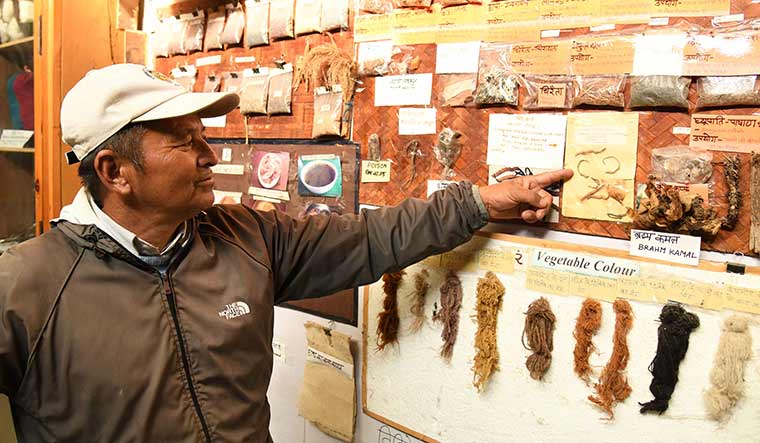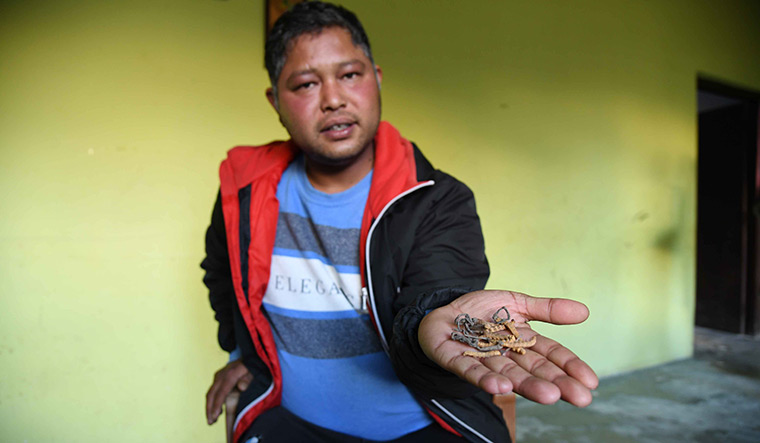Prerna Devi and her husband, Jagat Singh Ganghari, fall on their knees and bend over on the floor.
Prerna is 52 or thereabouts, Jagat 65. On a crisp November afternoon in Munsiyari―a quiet hamlet at 7,200ft in Uttarakhand’s Pithoragarh district―they are demonstrating how they burrow for the tip of a rare fungus in snow-peaked mountains.
In Munsiyari, often charmingly referred to as Little Kashmir, local residents often point to the five famous peaks, namely Panchachuli, girding the Kumaon region far into the horizon, as if the peaks are the source of all sustenance in this quaint little hill town perched between the borders of India, Tibet and Nepal.
Standing outside her spacious, pucca house on a broken road, Prerna looks petite and rough-hewn. She chirpily talks about walking over the remnants of a glacier from the Nanda Devi east base camp to search for keeda jadi or cordyceps―a mummified caterpillar fungus with a slender, brown body whose benefits were perhaps first described in An Ocean of Aphrodisiacal Qualities, a 15th century Tibetan medicinal text.
It is known as Yartsa Gunbu in Nepal and Tibet, a poetic name meaning summer grass, winter worm. The mushroom is renowned as ‘Himalayan Viagra’ for its rumoured use as a sexual stimulant. But Prerna is least concerned with such saucy connotations. For her family of three in Munsiyari, keeda jadi is the most important source of income in a region mostly amenable to growing potato, rajma and medicinal herbs.
This April, the couple trekked all the way to the Nanda Devi east base camp and climbed further ahead to procure keeda jadi. They managed to collect 400 pieces of the fungus hidden under patches where the snow had melted. On the way down, they sold off their collection to a thekedaar [contractor] for Rs10,000. The people of her village made a total of Rs10 lakh this year selling keeda jadi. In the international market, a kilogram of keeda jadi costs Rs65 lakh, making it perhaps the most expensive mushroom in the world, costlier than gold or diamonds.
“We didn’t even know such a valuable resource existed on our side of the Himalayas,” says Jagat, while calling attention to his bruised elbows and shins. “First, people from Nepal came quietly through the jungles and went up to collect this insect-herb. Then the people in Dharchula (a town in Uttarakhand, close to the Nepal border) got to know of this and they, too, headed for the mountains. We, in turn, got to know from the Dharchula folks when they descended the mountains.”
Jagat first learnt about keeda jadi in 2011 and has been a regular visitor to the higher reaches, often braving floods, snow-melt and avalanche to camp onsite from April to June every year. In 2013, his tent with all the rations, utensils and woollens tumbled down the valley as a glacier collapsed.
“The first time my wife and I went there, we didn’t get a single piece,” recalls Jagat. “It is hardly ever visible on the ground. You have to crawl on your knees and elbows, which start bleeding from the cold. You have to keep crawling. Every year there are casualties. So many have slipped on ice and died.”
He says he can trek 65km a day, his wife even more, although searching for keeda jadi is getting increasingly difficult with their faltering eyesight. “I will go one more time,” he says. “Just one last time next year.”
Prerna interjects: “At least our son has completed his education because of the money we earned from keeda jadi.” She explains how she soaks the unsold fungus in water for a week or two so the juice seeps out, and then drinks it up like a hot beverage.
The couple even eats it raw. “It has cured our fever, stomach ulcers and knee pain. Maybe, it is protecting us from the harsh, cold climate in the mountains, too. The buyers cannot afford to eat it because it gets more and more expensive. But we obviously can,” chuckles Prerna.
The rare plant-animal herb dictates fortunes in parts of Uttarakhand, specifically in the Pithoragarh belt. It grows abundantly in the bugyals (alpine meadows) of the state. In the fruiting season in spring, the mushroom pops out of the head of the exoskeleton of a dead caterpillar. The fruiting and harvesting are wrapped up in less than two months from mid-May to June.
Local healers and traditional practitioners list several uses of the magic fungi. C.S. Negi, professor of zoology at Motiram Baburam Government Postgraduate College in Haldwani, has been researching on keeda jadi for more than 15 years. In a 2016 paper, he lists how it can treat 21 different ailments, starting from erectile dysfunction, malignant tumours, bronchial asthma to diabetes, cough and cold, jaundice and alcoholic hepatitis.
“In some parts of Nepal, Yartsa Gunbu is powdered and combined with the rhizome of Dactylorhiza hatagirea [the creeping rootstalk of an orchid species found in the Himalayas] for consumption, which along with honey and cow’s milk is used as tonic and aphrodisiac. People of both sexes normally use a combined dose of one dried Yartsa Gunbu with half litre of milk and two teaspoons of ghee (clarified butter) for a week. Invariably, young or immature Yartsa Gunbu.... are recommended for the preparation of the sexual-stimulant,” states the paper published in the International Journal of Biodiversity and Conservation.
In Dharchula, it is often consumed with the local alcoholic brew called chakti. And in Munsiyari, one need not go to far-off, remote villages to find collectors of keeda jadi. From shopkeepers and tailors to an ex-armyman or gas station guard, everyone has a keeda jadi story to share.
The fungus has been widely used in Tibetan and Chinese medicine for centuries, and there are regulations on its harvesting and trade in the two countries. The Nepal government in 2020 disallowed the annual trek to harvest the fungi because of its near-constant depletion. The same year, the International Union for the Conservation of Nature listed it as “vulnerable” to extinction.
But there is little awareness or chatter around conservation of this precious resource on the Indian side of the Himalayan belt. Because the sale of cordyceps is banned in India, collectors and harvesters are always furtive around referencing keeda jadi even if a major chunk of their household income depends on it. Most of the produce is smuggled into Nepal for it to be legally traded to China, which sees the highest demand for the fungi.
Navin, a resident of Papari village in Munsiyari, runs a clothing store in the main town. He shows us videos of himself in gumboots, slashing snow with a wooden stick in the high altitudes to tease out keeda jadi. His family of five is cared for, thanks to him venturing into the mountains every year. The highest amount he has ever managed to earn by selling his haul in the last seven years is 03 lakh. This year, he made Rs80,000.
He loses his composure when he talks about keeda jadi’s price in the international market. “Our government is arresting us for selling something as natural and vital as keeda jadi,” he says. “We work hard, the land is ours, we do the collection but everything is going to Nepal and China. Why does it have to be this way?”
At the Tribal Heritage Museum in Munsiyari, samples of keeda jadi are quietly displayed behind a glass wall among artefacts of cooking pots, bowls, kettles and vanity boxes derived from the Bhotia people. An audio guide in Hindi blares out a guided tour of the private museum. When the narrator’s voice describes the discovery, uses and abuses of the magic herb, it encapsulates in a few pithy sentences the state of apathy keeda jadi lives under in India. “People are thoughtlessly scrambling for it. No one cares about tomorrow,” it warns.
Yogesh Rawat, a businessman, lives with his wife and daughter a few hundred metres away from the museum. He is originally from Bauna village in Pithoragarh. The same village was one of the first Indian outposts to learn about keeda jadi in its own backyard in 1999. Rawat has grown up seeing elders in his family sell keeda jadi, which, at one point, used to be Rs9,000 per kilogram.
“It is not like the yield of this insect-herb has gone down in the mountains. It is still the same. It is just that more people now land up to look for it,” says Rawat, as he pulls out two rolled-up paper pouches of the dried-up insect herb. One is set to go to Rajasthan and will sell for Rs70,000.
“I have the best stock,” he says. “All my clients from Rajasthan and Haryana are sportspeople. I go to Delhi Haat to sell other medicinal herbs but also establish contacts for keeda jadi. Now I don’t have to go anywhere for marketing. I get calls sitting here in Munsiyari.”
Rawat once made 033 lakh just from a week’s haul of keeda jadi. “Going to collect this mushroom is always like entering the jaws of death. We almost skate with our bare feet. We go to Panchachuli and pitch tents there. We do kirtan bhajans and wear lightly shaded clothes because dark clothes are worn by the goddess Nanda Devi,” says Rawat, indicating the respectful ways to keep the mountain deity in good humour before undertaking the dangerous task of harvesting the insect-herb.
Rawat is related to Love Raj Singh Dharmshaktu, who has climbed Mt Everest seven times. People who go up to search for keeda jadi are far more risk-taking trekkers, Rawat says. His only mission is to promote the herb in his own proactive way. “If we give GST for this, then it is not illegal. Indian scientists work for outsiders. If they spend one day on keeda jadi, India will make crores. Uttarakhand will not have to sell alcohol,”he says.
Rawat laments that research in the practical applications and medicinal uses of the herb is not done in India, even if there is limited scientific evidence to back the claims. But keeda jadi has helped his family save money on medical expenses. His wife’s joint pain, he says, magically disappeared after its consistent use over 15 days.
“We keep eating this all the time. We just feel very light,” he says. “When I eat this, I can walk 5km, instead of 1km. But you have to take it over a period of time. It is not like any English quick-fix medicine.”
Rawat wants the government to legalise the sale of keeda jadi for real conservation. “The maximum gold medals are won by Chinese athletes. Keeda jadi is the secret,” he says. “I am sure Xi Jinping also eats this. He doesn’t ever grow old.”





